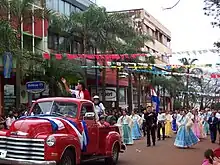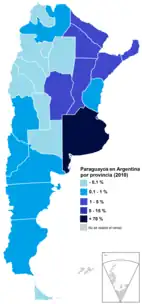Paraguayan Argentines
Paraguayan Argentines (Spanish: paraguayos-argentinos; Guarani: Paraguaiguakuéra Arahentínape) are Argentine citizens of full or partial Paraguayan descent or Paraguay-born people who reside in Argentina. Paraguayan people comprise an important ethnic group in the country due to the sustained immigration that gained importance in the 1970s. The number of people born in Paraguay living in Argentina has been estimated to be about 550,000.[1][2] Therefore, it is the largest foreign community in the country outnumbering individuals from Italy and Spain (countries which have been historically regarded as the origin of the backbone of Argentine society). It is also one of the fastest growing foreign nationalities. Despite all this, its numbers have been undercounted so it is believed that the real amount is even much higher.
 | |
| Total population | |
|---|---|
| c. 550.000 ~1,37% of the Argentine population | |
| Regions with significant populations | |
| Buenos Aires, Buenos Aires Province, Misiones, Corrientes, Formosa, Santa Fe, Córdoba and Chaco | |
| Languages | |
| Rioplatense Spanish · Paraguayan Spanish · Guarani | |
| Religion | |
| Roman Catholicism | |
| Related ethnic groups | |
| Paraguayans · Guaraní people · Argentines · Uruguayan Argentines |
History
The North-Eastern provinces of Argentina were originally inhabited by Guarani tribes conforming with what is now Paraguay and several regions of Brazil the area of influence of Guarani culture. This influence can be seen nowadays in many common cultural features. However, the earliest presence of Paraguayans as an ethnic group can be traced back much later, to the second foundation (and the real permanent settlement) of the city of Buenos Aires by Juan de Garay who sailed down Parana River from Asuncion accompanied by local Mestizo and Guarani families. In addition, there have always been certain connections between the two countries during later periods of the Spanish rule, especially when the Viceroyalty of the Rio de la Plata was created in 1776 which included several Intendencias, among them the Intendencia of Paraguay and Intendencia of Buenos Aires.
There has been Paraguayan presence in Argentine soil during and after the Paraguayan War and after the Revolution of 1947[3] in Paraguay but it did not acquire importance before 1970. For many economic reasons (Paraguay being an impoverished country) and political reasons (Stroessner dictatorship), Paraguayans started to settle in larger amounts throughout the wealthier neighbouring territory. Another fact was the porosity of Argentine borders and that the population density has always been disproportionally higher in the Eastern region (Argentine-Brazilian border) rather than the Western region or Chaco (Bolivian border).
Very different from other immigrant communities in Argentina (European and Middle-Eastern), Paraguayan entrance has been large (with insignificant return rate) and constant even to these days which makes up to 40 years of sustained immigration that does not seem to stop or decline in the future.
Distribution
According to the 2010 census [INDEC], the distribution of Paraguayan-born residents in Argentina is not evenly spread throughout Argentina's territory: Buenos Aires and the Buenos Aires Province are the top destinations for Paraguayans. In addition, due to geographical proximity facilitating movement and cultural exchange, 40% of the Paraguayan-born community is settled in provinces of the Northeastern region of Argentina, namely Misiones, Corrientes, Formosa, Santa Fe, Córdoba and Chaco, which are near the Argentina–Paraguay border. The 10% left is spread throughout the rest of the provinces.[4]
| # | Province | Paraguayan-born people | |
|---|---|---|---|
| # | % | ||
| 1 | 392,697 | 71.31 % | |
| 2 | 80,325 | 15.00 % | |
| 3 | 26,799 | 4.87 % | |
| 4 | 20,280 | 3.68 % | |
| 5 | 8,154 | 1.48 % | |
| 6 | 4,089 | 0.74 % | |
| 7 | 4,064 | 0.73 % | |
| 8 | 3,397 | 0.62 % | |
| 9 | 1,911 | 0.35 % | |
| 10 | 1,420 | 0.26 % | |
| 11 | 1,368 | 0.25 % | |
| 12 | 1,123 | 0.20 % | |
| 13 | 1,122 | 0.20 % | |
| 14 | 651 | 0.12 % | |
| 15 | 587 | 0.11 % | |
| 16 | 532 | 0.10 % | |
| 17 | 439 | 0.08 % | |
| 18 | 406 | 0.07 % | |
| 19 | 397 | 0.07 % | |
| 20 | 316 | 0.05 % | |
| 21 | 311 | 0.05 % | |
| 22 | 123 | 0.02 % | |
| 23 | 114 | 0.02 % | |
| 24 | 88 | 0.01 % | |
| Total | 550,713 | 100% | |
Traditions






Some cultural elements shared by Argentina and Paraguay include the consumption of Yerba Mate (Ilex paraguayensis) in the form of mate, a traditional infused drink with hot water claimed by Argentina, Paraguay and Uruguay as the national drink, as well as Tereré, a traditional infused drink with cold water and Mate cocido, a traditional infused drink with hot water, both originally from Paraguay; Chamame, folk music genre with its origins in Guarani Jesuit Missions mixed with European styles, and the use of the Guaraní Language, which is the official language of Paraguay and second official language of the Argentine Corrientes Province since 24 September 2004.
Guarani placenames in Argentina
Corrientes
Ituzaingó Curuzú Cuatiá Caá Catí Cerro Corá Mburucuyá ("Passion flower" the National flower of Paraguay) Mocoretá Tabay ("small town") Tapebicua Tatacuá ("the hole of the fire") Taragui Yahapé Yataytí Calle Yapeyú Itatí Itá Ibaté ("tall stone") Guaviraví Vaca Cuá Ita Corá Aguay
Misiones
Oberá ("shiny") Caa Yarí Capiobí Caraguatay Garuhapé Garuhapé-Mi Garupá Guaraní Itacaruaré Mbopicuá ("hole of the bat") Panambí ("butterfly") Pindapoy Piray Kilómetro 18 Puerto Iguazú (Iguazú meaning "large water") Puerto Piray (Piray meaning "small fish") Tarumá Tacuaruzú Cuña-Pirú
Chaco
Samuhú ("Chorisia" a kind of subtropical tree) Colonia Tacuarí El Paranacito
Salta
Aguaray Yariguarenda Yacuy El Aguay Acambuco Itangua Tobantirenda Capiazuti
Santa Fe
Tacuarendí ("sugarcane fields") El Arazá Caraguatay Aguará Grande Ñanducita ("small spider") Tacural ("anthills") Vera ("shiny") Carcarañá ("mean caracara")
Santiago del Estero
Añatuya Caburé Urutaú
Tucumán
Tukumã Tapia ("wall") El Timbo
Formosa
Pirané ("smelly fish") Ibarreta Yatai Tatané
Entre Ríos
Gualeguay Paraná Mandisoví Villaguay Ubajay Gualeguaychú Chajarí Ñancay Ibicuy
Buenos Aires Province
Pehuajó, Reta "retã" ("country or nation"), Mar de Ajó, Mar del Tuyú, San Bernardo del Tuyú, Ituzaingó ("waterfall")
Rivers
Paraná Paraguay ("colorful water") Uruguay ("water of the birds") Carapari Gualeguay Gualeguaychú Guayquiraró Rivers of the Paraná Delta Ibicuy
Notable Paraguayan Argentines
Politicians
.png.webp)
- Aníbal Ibarra (born 1958), former mayor of Buenos Aires
- Vilma Ibarra (born 1960), former congresswoman
Arts and culture
.jpg.webp)
- Arnaldo André (born 1943), actor
- Julio Bazan (born 1946), journalist
- Gabriel Casaccia (1907–1980), novelist
- Florencia de la V (born 1975), television presenter and vedette
- Mariana Enríquez (born 1973), novelist and short story writer
- Eloy Fariña Núñez (1885–1929), writer
- Pablo Lescano (born 1977), cumbia villera musician
- Ángel Menchaca (1855–1924), music theorist and composer
- Nelly Prono (1926–1997), actress
Sportspeople

- Roberto Acuña (born 1972), footballer
- Lucas Barrios (born 1984), footballer
- Raúl Bobadilla (born 1987), footballer
- Juan José Cáceres (born 2000), footballer
- Marcelo Cañete (born 1990), footballer
- Darío Espínola (born 1973), footballer
- Luis Fariña (born 1991), footballer
- Nicole Hain (born 2000), futsal player
- Juan Iturbe (born 1993), footballer
- David Martínez (born 1998), footballer
- Hilario Navarro (born 1980), footballer
- Leandro Paredes (born 1994), footballer and 2022 World Cup champion for Argentina
- Jonathan Santana (born 1981), footballer
References
- "Creciente número de paraguayos y bolivianos en Argentina :: Noticias de Bolivia de último momento". Fmbolivia.com.bo. Retrieved 2012-08-11.
- "Casi 300.000 paraguayos se radicaron en Argentina en 3 años". UltimaHora.com. Retrieved 2012-08-11.
- "Marco Teórico". Telpin.com.ar. 2001-01-14. Archived from the original on 2010-04-26. Retrieved 2012-08-11.
- "Censo 2010 - Población total nacida en el extranjero por lugar de nacimiento, según sexo y grupo de edad (ver por provincias)". National Institute of Statistics and Census (in Spanish). 2010. Archived from the original on 19 December 2015. Retrieved 26 December 2016.

.png.webp)
